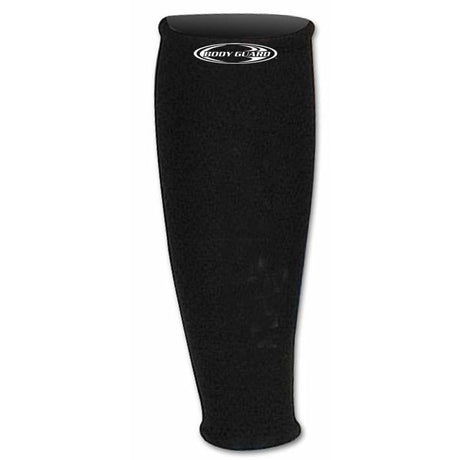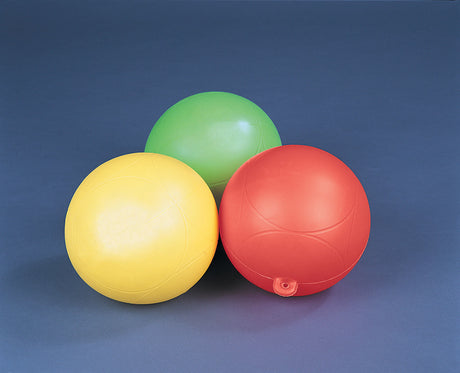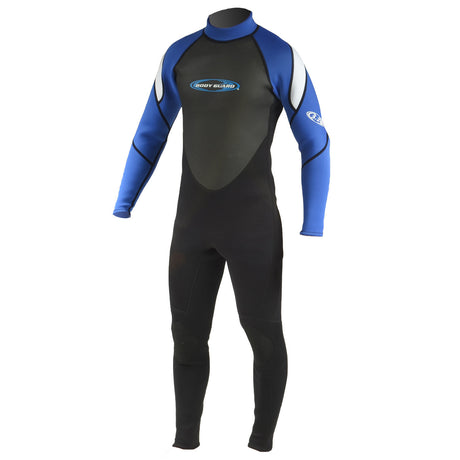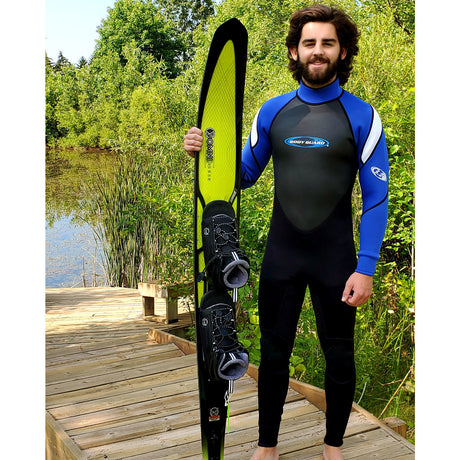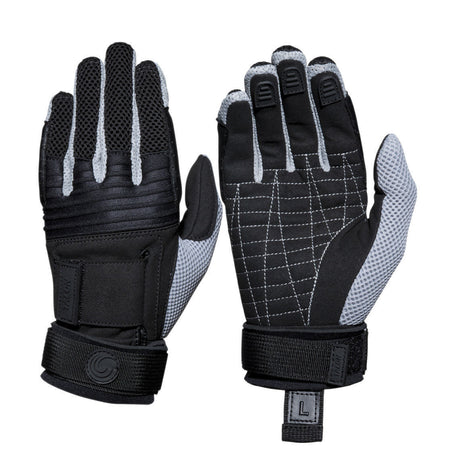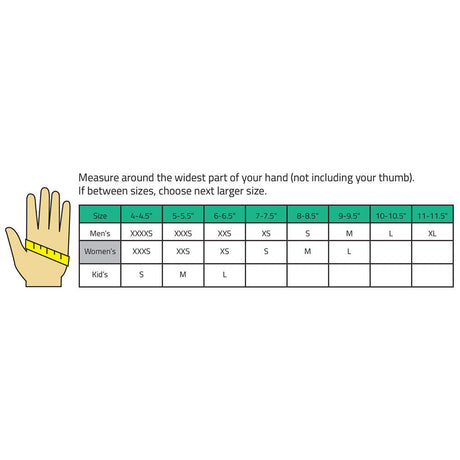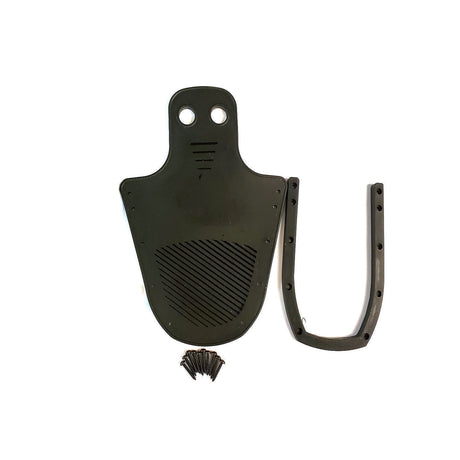Congratulations on your Aquaglide Water Trampoline purchase! These instructions provide the steps for setting up and anchoring your new Aquaglide trampoline. These instructions are applicable for the Recoil Tramp 14 and Tramp 17.
Verify Included Components
Before attempting assembly and inflation, verify your trampoline's package includes the following components:
Trampoline Parts
- 1x 4-Way Bridle
- 1x Jump Mesh
- 8x Sections of Galvanized Frame
- 8x Frame Sleeves
- 8x Frame Bolts
- 48x Stainless Springs
- 2x Spring Hooks
- 2x Allen Wrench
- 1x Spring Pad Cover
"C"-Deck
- 3x Vario-Lock Straps
Extras
- 1x Repair Kit
- 1x Owner's Manual
Trampoline Assembly
NOTE: Before beginning, you will need an inflation pump that is compatible with Halkey Roberts valves.
1. Lay Trampoline on Flat, Dry Surface
Unbox the trampoline and, before unfolding it, lay it out on a flat, dry surface. Ideally, you should stage the trampoline near the shoreline or dock. Don't drag the trampoline across any surface -- doing so many damage it. Once staged, unroll the trampoline.
2. Locate Main Valve to Inflate

The Halkey Roberts Valve is protected by a threaded backing plate. Using a flat tool or coin, rotate the plate clockwise to unscrew it from the valve (A).
Press your pump's inflation adapter into the valve. Twist it clockwise to lock it in the valve (B).

NOTE: Inspect the valve before inflation to ensure its plunger is extended outward. This allows for one-way airflow from the pump into the trampoline.
Inflate the trampoline to either 0.8 PSI (Recoil Tramp 17) or 1.2 PSI (Recoil Tramp 14).
After inflating the trampoline, replace the backing plate to protect the valve during use.
3. Inflate C-Deck Platform

Follow the same steps above to inflate the included C-Deck platform that attaches to the trampoline. For both Recoil Tramps (14 and 17), the C-Deck should be inflated to 0.8 PSI.
Do not attach the C-deck to the trampoline. The deck should be attached after the trampoline has been launched and anchored; this is covered below after assembly.
4. Assemble & Attach Steel Frame

Assemble the galvanized frame by inserting each section into the other at the ends.Lock each joint together using the frame through-bolts and the provided 5mm Allen tool (D).
Next, cover each bolt with a frame sleeve. Loosely attach the frame to the trampoline base using the frame straps. Once the frame is centered, tighten the straps.
5. Attach Jump Mat & Springs

Attach the jump mat by starting with two opposite corners (E1). When attaching the springs, ensure each hook is facing downward to prevent injury to users.
Work in a star pattern and attach only one spring at each corner, until all 8 corners have one spring. Then repeat the pattern to attach the second spring for each corner (E2).
NOTE: To avoid injury during this step, stretch the springs and pull the spring ends into the frame using the provided spring hook tool. Do not attempt to attach the springs using your fingers.
6. Attach Anchor Bridle to Steel Frame

The anchor bridle attaches to 4 of the 8 corners of the frame. The bridle's long ends (BLACK) must be attached in opposite corners, as must the short ends (WHITE), shown above (F1).

To attach the bridle, remove the webbing straps from the ends of the bridle, and sliding the end of the straps beneath the frame in each attaching corner.
Slide the lower end of the webbing strap around the frame, then pass it through the upper end of the strap (F3). Pull the strap tight (F4), then attach the strap to the bridle at the lower loop using the locking stainless steel quick link (F5).
7. Attach Spring Pad Cover

To attach the spring pad cover, begin with the outer perimeter. Push each webbing strap for the cover between the frame and tube. Connecting each strap loosely, ensure the cover's centered, then tighten each strap to secure the cover (G1).
Then attach the webbing straps for each connection point on the inner perimeter of the spring pad cover in the same fashion (G2).
8. Prep Anchor & Mooring Lines in Water

The trampoline can now be launched! Before launch, ensure the anchor and line are prepared and situated in the water, with appropriate open water space providing ample room for the trampoline and deck attachment.
NOTE: Read "Anchoring Requirements & Tips" below before launch.
9. Launch Trampoline & Secure Mooring Line
To launch the trampoline, lift the unit and carry it, with at least one person supporting 1 of 4 corners. Do not drag or push the trampoline across any surface; this will damage the unit and potentially cause a puncture.
Once in the water, secure the anchor line to the bridle assembly. Ensure the swimmer attaching the line is wearing a proper dive mask, and is supervised by another individual to prevent drowning.
10. Attach C-Deck to Trampoline Base

The C-Deck uses three stainless steel rings and adjustable locking straps to attach to the outer perimeter of the trampoline base. Float the deck atop the water to the desired attachment point, then loosely attach the center strap first (H1).

Next, loosely attach the outer left and right straps. Ensure each strap is centered on each ring (H2). Once all three straps are loosely attached, tightened each an equal distance to secure the deck to the base (H3 - H5).
Anchoring Requirements & Tips
Proper anchoring is essential for the safety of the trampoline's users, and the performance and lifespan of the unit. Professional anchoring services are recommended for installing this trampoline. If improperly anchored, the trampoline could be affected by weather, collide with boats or docks, and/or float away.
For Open Water Anchoring
Anchor the trampoline in an area protected from high winds and boat traffic. Confirm there is ample room for anchoring at the minimum water depth at a safe distance from hard objects and vertical surfaces.
Check the lake bed for debris and sharp or dangerous objects before planting the anchor and mooring line.
NEVER tie the trampoline to a dock or other structure above the surface of the water.
ALWAYS attach the anchor's mooring line of the center of the anchor bridle. NEVER attach the line to any side or corner of the trampoline base.
The recommended anchor weight for the Tramp 14 and Tramp 17 is at least 1,100 pounds (lbs) or 500 kilograms (kg).
For Commercial Pool Anchoring
Always attach each corner and/or side of the trampoline to pool anchor eyes rated for mooring. Adjust all the mooring lines so the trampoline is centered in the pool, with each line under tension. Use at least four lines to anchor the unit in any pool.
DO NOT place the trampoline near any edge of the pool; jumpers might otherwise injure themselves on the pool's ledges.
Operating Requirements & Tips
The Recoil Tramp series of Aquaglide trampolines is designed to function as a semi-permanent installation. As such, following the below operating tasks and tips is essential to ensuring the trampoline remains safe and functional.
Check the trampoline base's air pressure daily. Air pressure will change as ambient air temperature changes.
Disperse the load of users across the surface of the jump pad. Never concentrate more than 300 pounds in one spot on the trampoline.
Do not allow users to use the trampoline if strong winds (25 knots or more) are expected. During sustained high winds, the trampoline should be stowed.
Regularly inspect all straps, springs, the jump pad, the spring cover, and all mooring and anchor lines to ensure each remain secured and in good working order.
Ready to Add More Fun?
You might've noticed your Aquaglide trampoline comes with various attachment points -- it's designed to work alone, or part of a larger water feature set!
Shop Aquaglide water park features here! Bart's is your top trusted distributor for Aquaglide products, both residential and commercial.



